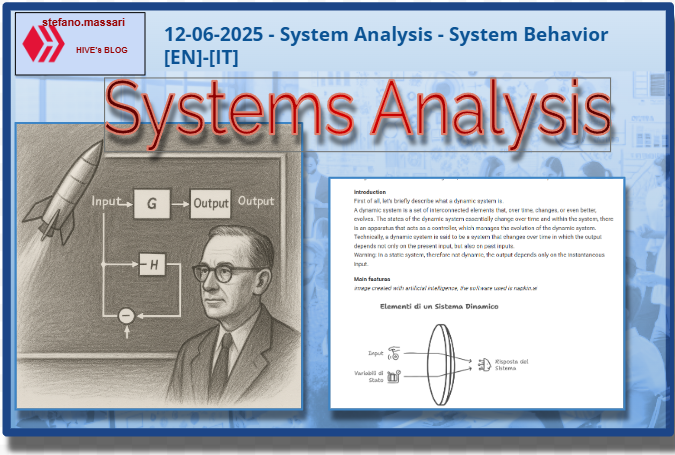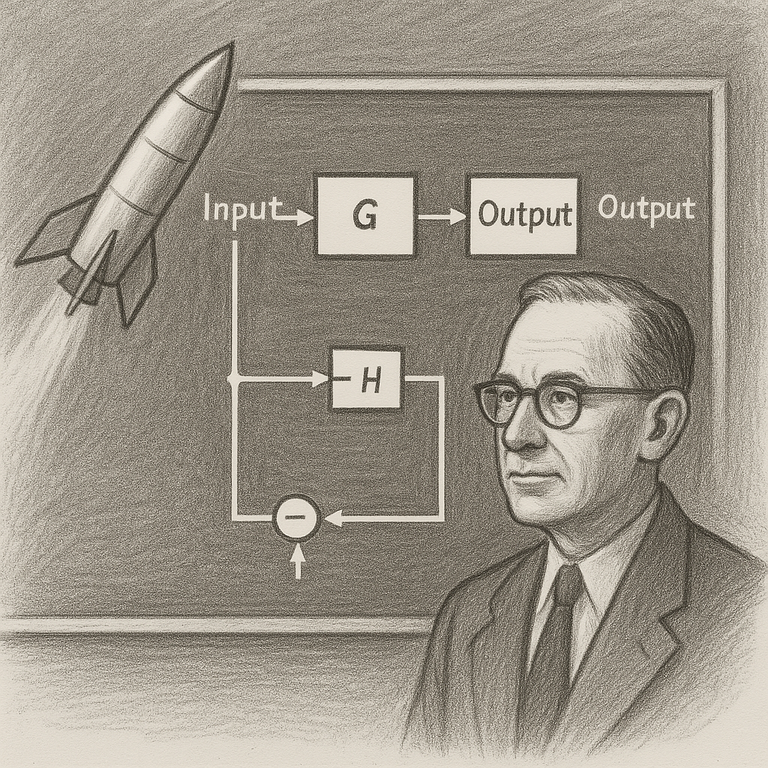12-06-2025 - System Analysis - System Behavior [EN]-[IT]

~~~ La versione in italiano inizia subito dopo la versione in inglese ~~~
ENGLISH

12-06-2025 - System Analysis - System Behavior [EN]-[IT]
With this post I would like to give a brief instruction about the topic mentioned in the subject
(code notes: X_87)

image created with artificial intelligence, the software used is Microsoft Copilot
Introduction
First of all, let's briefly describe what a dynamic system is.
A dynamic system is a set of interconnected elements that, over time, changes, or even better, evolves. The states of the dynamic system essentially change over time and within the system, there is an apparatus that acts as a controller, which manages the evolution of the dynamic system.
Technically, a dynamic system is said to be a system that changes over time in which the output depends not only on the present input, but also on past inputs.
Warning: In a static system, therefore not dynamic, the output depends only on the instantaneous input.
Main features
image created with artificial intelligence, the software used is napkin.ai

The main features of a dynamic system are:
-Input (u): external solicitation.
-Output (y): system response.
-State variables (σ, x, etc.): describe the instantaneous internal condition
Difference between static and dynamic model
Static models can be traced back to mathematical models in which the output variable is a function of the input variable only at the same instant.
A dynamic model, on the other hand, mathematically speaking, allows you to calculate the trend of the output variables as a function of the trend of the input variables. We can also say that in a dynamic model you are able to calculate the evolution as a function of the value of the initial conditions. Dynamic models can be parametric.
The types of static models that exist are:
Tables, graphs, analytical expressions linking input and output
The harmonic response
In the behavior of a dynamic system we must mention the harmonic response.
What is the harmonic response?
The harmonic response is the response of the system, in steady state, in correspondence with sinusoidal inputs.
The harmonic response is important when studying systems in which frequency analysis must be performed.
Studying the harmonic response allows you to build the Bode diagram or the frequency response of the system.
Phase diagram
In the study of the behavior of a system we must mention the phase diagram.
What is called a phase diagram, in systems analysis, is the Bode phase diagram, showing the phase of the harmonic response function as a function of the pulsation.
In the diagram we have the pulsation, or angular frequency, horizontally, on the vertical axis we have the phase of the transfer function.
Below is an example of a phase diagram

image created with artificial intelligence, the software used is ChatGPT
This diagram shows how the phase of the output signal varies as a function of the frequency of the sinusoidal input, and is essential for analyzing the stability and frequency response of dynamic systems.
module diagram
Also important in the study of the behavior of a system is the module diagram.
A module diagram is the Bode diagram of the modules, showing the module of the harmonic response function as a function of the pulsation.
In particular, the module diagram shows how the gain (usually expressed in decibels) varies as a function of the pulsation of the input signal.
Below is an example of the module diagram

image created with artificial intelligence, the software used is ChatGPT
Conclusions
When we study the behavior of a system we have two main phases:
-The analysis which consists in understanding the structure of how a system that must obtain a certain result must be composed
-The modeling which is the representation of that system, where the evolution of the dynamic system is shown.
Question
Hendrik Wade Bode (1905–1982) was an American engineer and mathematician. His studies are extremely useful for sizing closed-loop control systems. Did you know that the popular engineer (those who attended a technical school have certainly already heard his name), during the Second World War, worked on automatic guidance and fire control systems for the first missiles? Did you know that his work, carried out in the military field, later turned out to be a pillar of modern control engineering?

ITALIAN

12-06-2025 - Analisi dei sistemi - Comportamento di un sistema [EN]-[IT]
Con questo post vorrei dare una breve istruzione a riguardo dell’argomento citato in oggetto
(code notes: X_87)

immagine creata con l’intelligenza artificiale, il software usato è Microsoft Copilot
Introduzione
Innanzitutto descriviamo brevemente che cosa è un sistema dinamico.
Un sistema dinamico è un insieme di elementi interconnessi che con il passare del tempo, cambia, o ancora meglio, si evolve. Gli stati del sistema dinamico, sostanzialmente cambiano nel tempo ed all'interno del sistema, c'è un apparato che funge da controllore, il quale gestisce l'evoluzione del sistema dinamico.
Tecnicamente si dice che un sistema dinamico è un sistema che cambia nel tempo in cui l'uscita dipende non solo dall'ingresso presente, ma anche da quelli passati.
Attenzione: In un sistema statico, quindi non dinamico, l'uscita dipende soltanto dall'ingresso istantaneo.
Caratteristiche principali
immagine creata con l’intelligenza artificiale, il software usato è napkin.ai

Le caratteristiche principali di un sistema dinamico sono:
-Input (u): sollecitazione esterna.
-Output (y): risposta del sistema.
-Variabili di stato (σ, x, etc.): descrivono la condizione interna istantanea
Differenza tra modello statico e dinamico
I modelli statici possono essere ricondotti a modelli matematici in cui la variabile di uscita è funzione della sola variabile d'ingresso allo stesso istante.
Un modello dinamico, invece, matematicamente parlando, consente di calcolare l'andamento delle variabili di uscita in funzione dell'andamento delle variabili di ingresso. Possiamo dire anche che in un modello dinamico si è in grado di calcolare l'evoluzione in funzione del valore delle condizioni iniziali. I modelli dinamici possono essere di tipo parametrico.
I tipi di modelli statici che esistono sono:
Tabelle, grafici, espressioni analitiche leganti ingresso e uscita
La risposta armonica
Nel comportamento di un sistema dinamico dobbiamo menzionare la risposta armonica.
Cos'è la risposta armonica?
La risposta armonica è la risposta del sistema, a regime permanente, in corrispondenza di ingressi di tipo sinusoidale.
La risposta armonica è importante quando si studiano sistemi in cui si devono effettuare analisi di frequenza.
Studiare la risposta armonica permette di costruire il diagramma di Bode o la risposta in frequenza del sistema.
Diagramma delle fasi
All'interno dello studio del comportamento di un sistema dobbiamo citare il diagramma delle fasi.
Quello che viene chiamato diagramma delle fasi, in analisi di sistemi, è il diagramma di Bode delle fasi, riportante la fase della funzione di risposta armonica in funzione della pulsazione.
Nel diagramma abbiamo in orizzontale la pulsazione, o frequenza angolare, sull'asse verticale abbiamo la fase della funzione di trasferimento.
Qui di seguito un esempio del diagramma delle fasi

immagine creata con l’intelligenza artificiale, il software usato è ChatGPT
Questo diagramma mostra come la fase del segnale in uscita varia in funzione della frequenza dell’ingresso sinusoidale, ed è essenziale per analizzare la stabilità e la risposta in frequenza dei sistemi dinamici.
diagramma dei moduli
Sempre nello studio del comportamento di un sistema è importante anche il diagramma dei moduli.
Si intende per diagramma dei moduli, Il diagramma di Bode dei moduli, riportante il modulo della funzione di risposta armonica in funzione della pulsazione.
In particolare, il diagramma dei moduli mostra come varia il guadagno (espresso solitamente in decibel) in funzione della pulsazione del segnale in ingresso.
Qui di seguito un esempio del diagramma dei moduli

immagine creata con l’intelligenza artificiale, il software usato è ChatGPT
Conclusioni
Quando studiamo il comportamento di un sistema abbiamo due fasi principali:
-L'analisi che consiste nel comprendere la struttura di come deve essere composto un sistema che deve ottenere un certo risultato
-La modellistica che è la rappresentazione di quel sistema, dove viene mostrata l'evoluzione del sistema dinamico.
Domanda
Hendrik Wade Bode (1905–1982) è stato un ingegnere e matematico statunitense. I suoi studi sono estremamente utili per dimensionare sistemi di controllo in anello chiuso. Lo sapevate che il popolare ingegnere (chi ha fatto una scuola tecnica ha sicuramente già sentito il suo nome), durante la seconda guerra mondiale, lavorò su sistemi di guida automatica e controllo di fuoco per i primi missili? Lo sapevate che il suo lavoro, svolto in ambito militare, si è poi rilevato un pilastro dell’ingegneria del controllo moderna?
THE END
Come sempre la guerra e le armi spingono la tecnologia in avanti, mai farlo per scopi pacifici... Devo dire che non avevo mai sentito parlare di Bode, forse è più per il settore elettronico
!PIZZA
Non hai mai sentito nominare Hendrik Wade Bode?! Pensavo di si. Io sono un perito industriale, ho frequentato alle superiori un Istituto Tecnico Tecnologico…. E devo dire che di BODE ne abbiamo parlato tanto.
Ho fatto l'itis io, però o l'ho totalmente cancellato o l'hanno saltato nel programma 😅
$PIZZA slices delivered:
davideownzall tipped stefano.massari
@stefano.massari(1/5) tipped @lupega
Come get MOONed!
I think I now understand this very much on how it is been done compared to many years ago
Thanks for leaving a comment. In this article I wanted to describe that systems have a defined behavior. A dynamic model is defined by:
-States
-Inputs
-Outputs
-Laws of evolution
!HUG
He has a nice concept though
He’s then one of the most relevant people in the Second World War…
Bode's magnitude-phase diagrams, devised in 1938, are useful for studying the stability of frequency systems. Bode became director of mathematics at Bell Labs. He made important contributions to the analysis of systems !hiqvote
https://x.com/lee19389/status/1933286336946925986
#hive #posh
La seconda guerra mondiale, questo mi fa pensare alle notizie di attualità, immaginate se alcuni paesi usassero le loro armi nucleari, sarebbe devastante, le guerre muovono l'economia, ma lasciano complicati danni collaterali.
La seconda guerra mondiale ha fatto partire lo studio dei sistemi dinamici in maniera professionale. Infatti un sistema dinamico puó essere basato su equazioni differenziali.
I modelli risultano utili per simulare, analizzare stabilità, prestazioni e sensibilità di un sistema. Credo che le guerre di oggi, quando si studiano a tavolino, vengano tutte studiate come sistemi dinamici. !PIZZA
@stefano.massari, I paid out 0.123 HIVE and 0.022 HBD to reward 7 comments in this discussion thread.